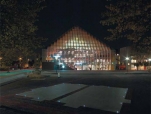Book Mountain behind Glass

The new public library in the town of Spijkenisse (Spijkenisse), the Netherlands, called the “Book Mountain” (Book Mountain). But it is not only a single feature that several tiers of pyramidal shape building can accommodate 150 thousand books, but also that they are in the fact all behind the glass.
Transparent walls of the building stipulate maximum penetration inside the daylight, and let you see the bookshelves even from the street. Unusual interior attracts people who previously were not very interested in reading.
The library is designed as an advert for reading, its visible presence and invitation holding great significance for a community with 10 percent illiteracy. From underneath the glass dome the library is visible from all sides, especially from the adjacent market square where the library appears as one big book mountain. Underneath its monumental glass envelope damage to the books by sunlight is off-set by their normal 4 year life-span due to wear and tear from borrowing.
Located in the centre of Spijkenisse, the library with a total area of 9.300m², sits on the market square next to the historical village church. Besides the library the building houses the environmental education centre, a chess club, auditorium, meeting rooms, commercial offices and retail. The exterior of the library refers in shape and materiality to the traditional Dutch Farm, a reminder of the towns agricultural past, which has grown from farming village to Ville Nouvelle in the past 40 years.
The library had to accommodate a number of other partly commercial functions. The stacking of this nonlibrary programme forms a pyramidal base on which platforms are projected, housing the libraries bookshelves and shaping a powerful symbol. The book platforms are connected via wide stairs and together form a continuous route of 480 meters around the mountain to its peak where a café offers panoramic views over this Dutch Newtown.
In order to connect the former village centre visually and distinguish clearly between commercial and library programme, a ‘blanket’ of brick is laid over the neighbourhood and the libraries pyramidal heart. The Library sits on top of this with its floors, walls, ceilings and even doors made of the same brick. This consequent materialisation supports the public status of the library by communicating clearly the difference: behind the glass hood a library is visible, behind the brick sits the rest of the program.
Another reference to the towns agricultural past lays in the libraries bookshelves. Made of recycled flowerpots these elements are simultaneously fireproof and economic and provide a perfect background to the books and accompany the visitors through the building by taking on the functions of banister, parapet, information desk and bar. They form another element in the building’s palette of brick, glass and wood: recycled materials. Book shelves out of reach play an important visual role, housing the libraries archive.
Full content of this issue you can read here
The full version of the article can be read in our printed issue, also you can subscribe to the web-version of the magazine.
 Materials provided by MVRDV
Materials provided by MVRDV


